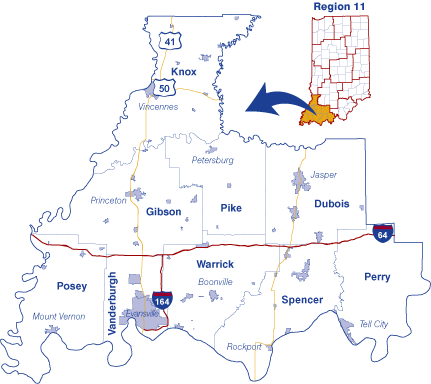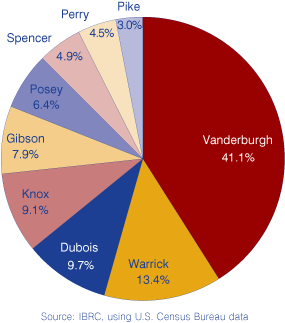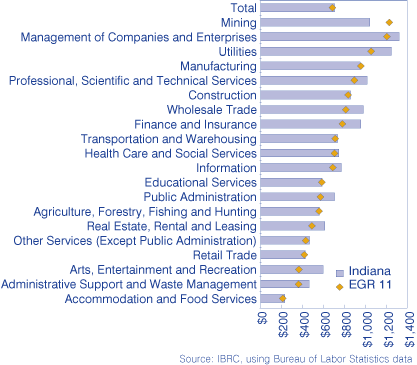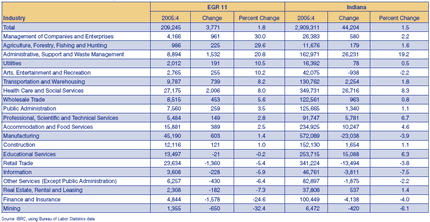Regional Perspective: Economic Growth Region 11
Economic Growth Region (EGR) 11 is located in the south-westernmost tip of Indiana and is made up of nine counties: Dubois, Gibson, Knox, Perry, Pike, Posey, Spencer, Vanderburgh and Warrick. The approximate 421,400 people in these nine counties made up 6.7 percent of the state's population in 2005, down from 6.8 percent in 2000. So how are those 421,000 plus people distributed within the region? More than 41 percent reside in Vanderburgh County while another 13.4 percent are in Warrick County (see Figure 1). Pike County made up the smallest proportion of the region with 12,766 people (3 percent).

Figure 1: EGR 11 Population Distribution, 2005

As far as change in population over the last five years, Knox County was hit the hardest, with decreases every year except from 2002 to 2003, where it saw a mild increase of 45 people. Over the five-year span, Knox County experienced a decrease in population of more than 800 people (see Figure 2). At the other end of the spectrum, Warrick County increased every year by at least 390 residents and had an overall increase of about 3,780 people. Despite decreases in two thirds of the counties at some point in time over the five years, EGR 11 saw an overall increase of 6,290 people.
Figure 2: Change in Population in EGR 11, 2000 to 2005

Jobs
Manufacturing supplied more jobs than any other industry in the region. Similar to the state was the numeric increase in health care and social services jobs, which added the most at both the regional and state levels from 2001 to 2004. Where the two geographies differed was change in manufacturing jobs. At the regional level, jobs in the manufacturing industry saw an increase of 1.4 percent while Indiana posted losses of 3.9 percent (see Table 1).
Table 1: Change in Jobs in EGR 11, 2001:4 to 2005:4
Regardless of its increase in manufacturing jobs, many manufacturing workers in the region appear to be browsing for openings. According to the Research and Analysis division at Indiana's Department of Workforce Development, the top five categories of people looking for jobs in Region 11 are assemblers (factory work), production laborers, all other machine operators, all other hand workers, and forklift/industrial truck operators (as of September 10, 2006). Table 2 shows the top 20 jobs being sought out by workers in the area.
Table 2: Top 20 Jobs being Sought in EGR 11

Two industries in the region experienced double-digit percent losses: the mining industry decreased jobs by 32.4 percent, and the finance and insurance industry saw a 24.6 percent decline. The good news for EGR 11 is that while two industries lost a significant amount of jobs, there were five industries with double-digit percent increases that more than compensated for those losses. Overall, there were just over 10,000 establishments supplying 209,245 jobs in EGR 11 in the fourth quarter of 2005, an increase in jobs of 1.8 percent from the same time in 2001. This was a faster pace than the state overall, which saw a 1.5 percent increase over that time span.
Wages
The average weekly wage in Indiana for the fourth quarter of 2005 across all industry sectors was $705. EGR 11 paid $687 per week, a difference of $18. However, Region 11 is improving, albeit slowly, from a difference in 2001 of $19. In fact, eight of the 20 major industry sectors shown in Figure 3 increased wages by more than the state, helping to narrow the gap in wage differences.
Figure 3: Average Weekly Wages in EGR 11 and Indiana, 2005:4

In Indiana, all major industry sectors increased wages since 2001. At the regional level, only finance and insurance saw a decrease in wages (down $21 from its 2001 level). Management of companies and enterprises increased wages the most at both the regional and state levels, by $217 and $223, respectively. After these large increases, the management of companies and enterprises industry maintained its lead as highest paying industry at the state level, and only mining paid more in EGR 11.
Commuting
Of the 201,357 people who live in EGR 11 and work anywhere (defined as the regional labor force), 95.3 percent choose to work within the region; of the regional labor force, 72.8 percent live and work in the same county. About 9,500 people live in the region and commute out of it for work, while approximately 6,200 live outside the region but commute in for work.
As for those who live and work within the region, Knox County was the only county that didn't send workers to every other county in the region, leaving Spencer out of the mix and sending out the fewest number of workers (764) to fellow EGR 11 counties. Warrick County was the most generous with its workers, sending out 16,071 workers to the other eight counties and keeping only 9,615 for itself. Figure 4 shows the commuting patterns for the region.
Figure 4: EGR 11 Commuting Patterns, 2000

Molly Manns, Research Associate
Indiana Business Research Center, Kelley School of Business, Indiana University

